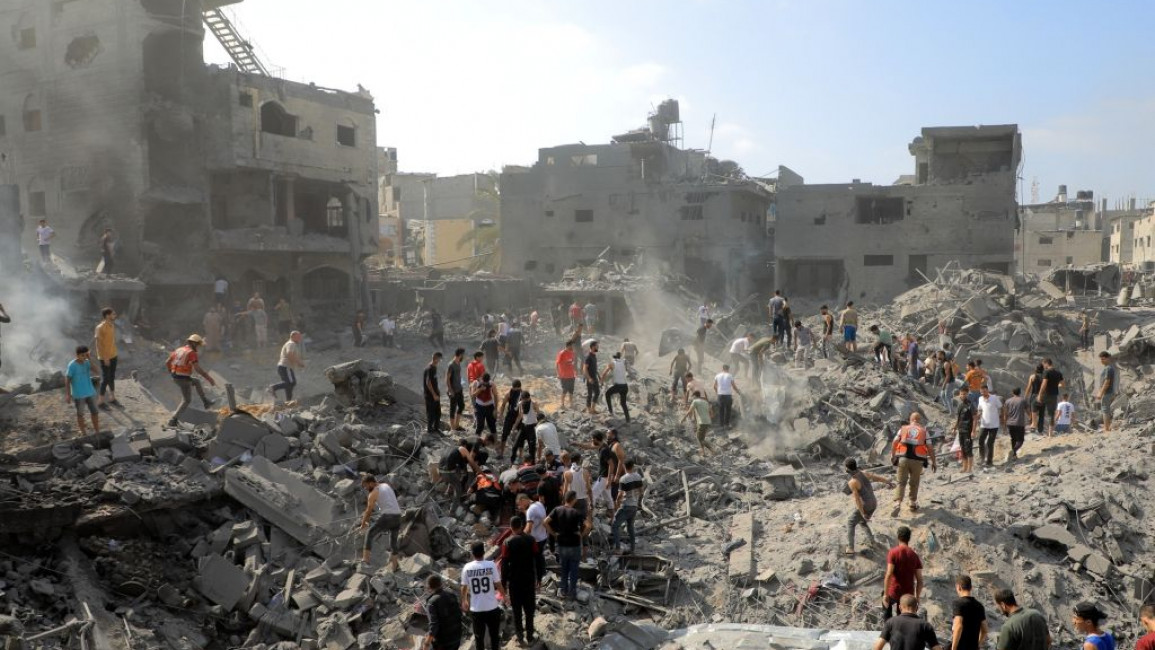What do we know about the Jabalia refugee camp, bombed twice by Israel?
Israeli airstrikes targeted Jabalia refugee camp in the northern Gaza Strip for two days in a row on Tuesday and Wednesday with 195 Palestinians being killed and a further 777 injured in both strikes according to Gaza's Ministry of Health.
The attack on the camp comes amid Israel's ongoing ground invasion of the Gaza Strip and a series of indiscriminate airstrikes which has killed 9,061 Palestinians including 3,760 children.
Jabalia refugee camp is the largest of eight refugee camps in the Gaza Strip, with a population of 116,011 people living in a 1.4 square kilometre area, making it one of the most densely populated areas in the Gaza Strip.
According to the UN, it currently holds scores of United Nations Relief and Works Agency for Palestine Refugees (UNRWA) facilities including 26 schools, a food distribution centre, two health centres, two relief and social services offices, a library, seven water wells and a maintenance and sanitation office.
Despite UNRWA's assistance, prior to the war, the camp suffered electricity cuts, a contaminated water supply that made 90 percent of water in the camp unfit for human consumption, and a lack of construction material.
It was initially formed following the 1948 Arab-Israeli war and the resulting Nakba which saw refugees flee from across Palestine to the Gaza Strip and settle in Jabalia and the seven other refugee camps; al-Shati, Bureij, Deri el-Balah, Khan Younis, Maghazi, Nuseirat, and Rafah.
The camp was also the site of the outbreak of the First Intifada in 1987 by Palestinians against Israel's occupation. It was subsequently declared a "closed military zone" by Israel.
Its proximity to the Erez border crossing and the Israeli border has meant that Jabalia camp has a history of being attacked by Israel, with an airstrike on a UN school inside the camp killing 20 people during the 2014 Gaza war.
Since the beginning of the current war Jabalia camp has been hit by Israeli airstrikes on six separate occasions - including on 9, 12, 19, and 22 October - in addition to the two deadly strikes on Tuesday and Wednesday.
The indiscriminate strikes, as well as an Israeli order to evacuate the north of the Gaza Strip, have seen hundreds of thousands of people flee south.
However, many Gazans from the north have also fled from around Gaza City into Jabalia refugee camp, including those from Beit Hanoun and Beit Lahia near the Israeli border who took shelter in UNRWA schools.
Other people have had to seek shelter with family members in the camp.
One resident who was displaced from Beit Hanoun, Mohammed Abu Oda, told The New Arab that he had lost six family members during the Israeli strikes on the camp.
He said that "the camp is the capital of north Gaza," full of life even with strikes occurring around the Strip, with children playing in the streets "to get rid of their internal fears."
But he added that Jabalia had now become a ghost city, with the streets empty for fear of new Israeli strikes.
With Israel moving further into the Gaza Strip, residents can now hear heavy clashes between the Israeli army and Hamas taking place around them.
A security source close to Hamas told The New Arab that "Israel deliberately attacked the refugee camp as it houses most of the leaders, not only in Hamas but also in other armed factions."
However, he added that rather than killing Hamas fighters in the strike, it was the militants who had killed "dozens" of Israeli soldiers in the recent fighting.
"The soldiers know very well that Jabalia is their cemetery and [it] will not be available and easy for them [to take], so they bomb it with aircraft all the time, thinking that they will be able to storm it by ground.
He added that Jabalia, along with all parts of the Gaza Strip, supported "the resistance."
The UN warned on Wednesday that "given the high number of civilian casualties and the scale of destruction following Israeli air strikes on Jabalia refugee camp, we have serious concerns that these are disproportionate attacks that could amount to war crimes."
A Guardian visual investigative analysis quoted weapons experts as saying that the five craters in the camp left by Tuesday's strikes were either caused by multiple joint strike attack munitions (JDAMs) or guided bomb units (GBUs), both guided bomb kits used for targeted strikes.
The bombs used target underground tunnels, with the burrowing effect of the bombs causing buildings to collapse in on themselves. The bombs however will also indiscriminately destroy civilian buildings.
Exports who spoke to the Guardian stated that the scale of destruction means it will be hard for Israel to justify said strikes.
The EU's High Representative for Foreign Affairs Josep Borrell stated he was "appalled by the high number of casualties following the bombing by Israel of the Jabalia refugee camp."



